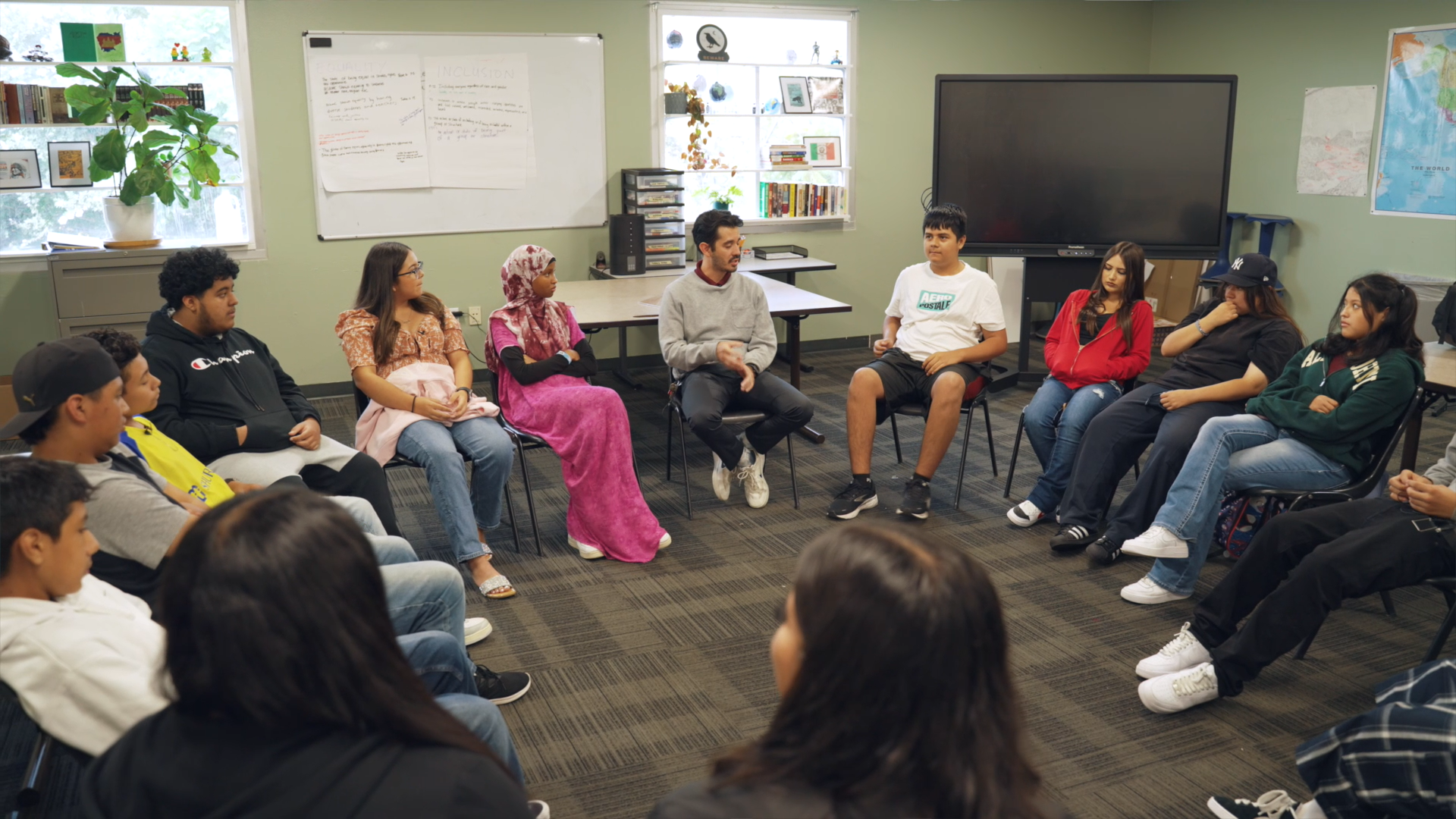If you’d asked me in 2013 to list my classroom struggles, “Beginning units in a way that helped students authentically engage with the content” wouldn’t have made my top 20. At that time, I had more than a decade of experience teaching several different subjects and grade levels, and I considered myself to be pretty good at finding meaningful kick-off activities. For example, before my 7th graders read A Midsummer Night’s Dream, I had them play the “tossing lines” game (Folger Shakespeare Library, 2006). They threw a ball around the room and whoever caught it said an assigned line from the play. Based on these lines, the class then predicted what the play was about. This was a fun way to get students’ attention and prepare them to access a challenging text.
Accessing knowledge, focusing attention, and setting goals are all important ways to prepare for new learning, and my students participated in the activities. These are good results—yet I felt like something was missing. I didn’t know what that was until I started learning about contextual psychology, a branch of evidence-based behavior science whose practitioners (mostly clinical psychologists) teach people how to discover and do what truly matters to them—as opposed to doing whatever seems fun or comfortable in the moment—so their lives become more fulfilling and more theirs.
I wanted more than participation and achievement for my students. I wanted school to be a source of meaning, vitality, and community in their lives.
I realized I wanted more than participation and achievement for my students. I wanted school to be a source of meaning, vitality, and community in their lives. They were the ones who would ultimately choose whether and how to bring their values to their actions and interactions at school. My job was to create a learning environment that invited, enabled, and empowered students to make that choice.
I started developing tools and strategies teachers like me could use to invite, enable, and empower students to bring their values to their actions. One of those strategies is values activation.
For students, values activation means noticing how an upcoming unit offers opportunities for them to do work they’ll find important, affirming, and fulfilling, but they might not notice without my help.
Values Activation in the Classroom
As an educator, leading values activation means inviting, enabling, and empowering students to notice how an upcoming unit offers opportunities for them to do work they’ll find meaningful so school becomes a source of meaning, vitality, and community in their lives. To do that, we need to:
- Share enough information about the unit that students can imagine engaging in it. Consider writing a unit summary that explains what students will learn, what they’ll do to learn, any products or performances they’ll create, and any resources they’ll use.
- Have students respond to questions that expand their awareness of how the unit content might connect to sources of meaning in their lives. In my new book, Teach for Authentic Engagement, I offer some examples of the kinds of questions teachers can use to activate student values:
- What about this unit makes you curious?
- What are you learning about in other places—at home, in your other classes, or in your out-of-school life—that this unit relates to?
- What do you hope to have accomplished by the end of the unit?
- How is this unit an opportunity for you to be creative? (You can substitute any quality for creative—perhaps compassionate, responsible, appreciative, trustworthy, or playful. If your school has certain core values, consider using them in this question.)
- Who might experience this unit differently from how you will?
- Why will your future self be glad you learned about this unit’s topic or did this unit’s work?
- How will your community benefit from you learning about this topic or doing this work?
- Whose legacy does this work help you carry forward?
- Invite students to share their responses. This is a simple way to build a learning community where students affirm their own values, support each other in enacting their personal values, and discover common values.
Beginning a unit with questions like these and having a discussion around them is fundamentally different from methods teachers typically use and that I, too, had used: retrieving prior knowledge, capturing attention through fun activities (such as “Tossing Lines”), and having students set goals. Let’s look more closely at how they differ.
Values Activation vs. Knowledge Activation
Most units include knowledge activation. When students catalog what they know about a given topic, they can fit new knowledge into existing networks of meaning. For example, for our unit on coming-of-age novels, students drew images they associated with maturity and looked for common themes. Activating knowledge might include students listing things they know about the unit topic, agreeing or disagreeing with various statements (such as “everyone matures eventually”), or telling stories about their experiences (such as by sharing times when they felt mature). Making space for students’ existing knowledge honors the sources of that knowledge—their homes, families, personal pursuits, and cultural traditions—and can promote equity and belonging at school.
Values activation promotes equity and belonging: by connecting their upcoming work to sources of meaning in their lives, students can affirm who they are.
Knowledge activation helps students remember what they know so they’re better equipped to learn. Values activation helps them discover their own reasons for engaging in that learning. After drawing their images of maturity, my 7th graders looked at one another’s images to note common themes and interesting differences. Then, they wrote about what aspects of coming of age made them curious, how other classmates might experience the unit differently, and why their future selves would be glad they’d explored the unit topic. Values activation, too, promotes equity and belonging: by connecting their upcoming work to sources of meaning in their lives, students can affirm who they are and can make the classroom a place where they can all do something that matters to them.
Values Activation vs. Attention Activation
Teachers often devise ways to capture students’ attention at the beginning of the unit, like the “tossing lines” game described earlier. My former colleague Kelly begins her unit on cellular biology by dressing as “Kel the Cell.” Her students are immediately curious and ask about the organelles taped to her costume. Other attention-grabbers include games, simulations, escape rooms, art activities, field trips, and experiments.
With values activation, we’re not so much capturing students’ attention as empowering them to discover how the material connects to something important to them—and is, therefore, itself important enough to merit their attention. Imagine that after asking questions about their teacher’s cell costume, Kelly’s students read a description of the upcoming unit and write about how it’s an opportunity for them to be creative and how they and their communities might benefit from the work they do. After noticing these connections, the students are more aware of how they can choose to make their work important.
Values Activation vs. Goal Activation
Having a goal means identifying some desirable outcome. Being able to use the passé composé, understanding photosynthesis, throwing a football, and yes, getting at least a 90 on the unit test are all outcomes a student might want. Once they’ve identified a desirable outcome, a student can choose behaviors that make that outcome more likely to occur. Goal setting is a powerful way to encourage behaviors that lead to achievement—but maybe we’re after more than just achievement.
According to psychologist Matthieu Villatte and his colleagues (2016), when we see our actions as leading to a particular outcome, we feel satisfaction only if and when we achieve that outcome, but when we see our actions as part of living meaningful lives and being our best selves, the actions feel satisfying in and of themselves. For example, if a student listens attentively in science class because she wants to understand photosynthesis and get a 90 on the test, she’ll feel satisfied only if and when she understands and gets the 90. Neither outcome is guaranteed even if she tries her best, and both occur after she’s done the work of listening attentively. If a student listens attentively in science class because she sees attentiveness as an important part of how she wants to live, then her act of listening will be satisfying in and of itself.
When we help students notice the values they want to bring to a particular unit, we give them an opportunity to derive satisfaction from engaging in class.
When we help students notice the values they want to bring to a particular unit, we give them an opportunity to derive satisfaction from engaging in class. We hope their engagement will have additional benefits—gaining knowledge, doing well on assessments, getting into college, and having a successful career—but regardless of what happens in the future, they can find fulfillment right now when they act in accordance with their values. That was what I wanted for my students: success on their own terms, both in the future and in the present.
A Ritual Worth Creating
Values activation doesn’t necessarily replace goal-setting, attention-getting, or knowledge-evoking activities; you might simply add it to your repertoire of ways to begin a unit. That said, if you start every unit with values activation, the process will become a ritual that signals to your students that they’re starting something new and, therefore, have a new opportunity to make their work meaningful and satisfying. Over time, students come to expect values activation at the beginning of each unit, which helps orient them within their own learning and as a learning community.
Teach for Authentic Engagement
Strategies, tools, and classroom anecdotes that help students authentically engage with the content, with their work, and with each other.









